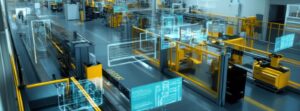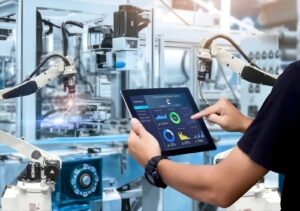
Contents
- 1 Machine Learning Predictive Repair in Manufacturing
- 1.1 What’s Predictive Upkeep?
- 1.2 How Machine Studying Permits Predictive Upkeep
- 1.3 Key Machine Studying Strategies in Predictive Upkeep
- 1.4 Advantages of Machine Studying Predictive Upkeep in Manufacturing
- 1.5 Actual-World Functions of ML Predictive Upkeep
- 1.6 Challenges in Implementing Machine Studying for Predictive Upkeep
- 1.7 The Way forward for Predictive Upkeep in Business 4.0
- 1.8 Conclusion
Machine Learning Predictive Repair in Manufacturing
Machine Learning :In immediately’s fast-paced industrial panorama, producers are underneath fixed strain to enhance productiveness, decrease downtime, and cut back operational prices. Conventional upkeep methods, resembling reactive or scheduled upkeep, are not enough to satisfy these calls for. Predictive upkeep (PdM), powered by machine studying (ML), is rising as a game-changer for contemporary manufacturing. By leveraging data-driven insights, predictive upkeep permits producers to foresee gear failures earlier than they occur, guaranteeing seamless operations and optimized useful resource utilization.

What’s Predictive Upkeep?
Predictive upkeep is a proactive method that makes use of information evaluation and superior algorithms to foretell when a machine or part is more likely to fail. Not like reactive upkeep, which fixes gear after breakdown, or preventive upkeep, which follows a hard and fast schedule, predictive upkeep optimizes servicing primarily based on real-time machine well being. The result’s a big discount in sudden failures, expensive downtime, and pointless half replacements.
Machine studying performs a vital position on this method by analyzing giant volumes of knowledge from sensors, IoT gadgets, and historic upkeep information. With the flexibility to detect patterns and anomalies, ML fashions can present correct predictions about future gear habits.
How Machine Studying Permits Predictive Upkeep
Conventional predictive methods usually relied on rule-based programs, which required human specialists to outline thresholds and parameters. Machine studying revolutionizes this by robotically studying from information and enhancing predictions over time. Right here’s how ML integrates into predictive upkeep:
1. Knowledge Assortment from Sensors
Trendy manufacturing gear is supplied with IoT sensors that measure parameters like temperature, vibration, strain, and power consumption. These sensors repeatedly generate time-series information.
2. Function Extraction and Knowledge Preprocessing
Machine studying fashions require significant options derived from uncooked sensor information. For instance, vibration information from motors may be reworked into frequency patterns that reveal early indicators of wear and tear or imbalance.
3. Mannequin Coaching
Supervised and unsupervised learning algorithms are employed to train predictive models. Supervised studying requires historic failure information, whereas unsupervised approaches (e.g., clustering or anomaly detection) establish deviations from regular habits with out prior failure labels.
4. Failure Prediction
As soon as skilled, these fashions can forecast gear well being and predict failures effectively upfront. Upkeep groups obtain alerts, enabling well timed interventions.
5. Steady Enchancment
ML fashions turn into extra correct as they’re fed extra information. Producers can replace and refine algorithms to adapt to new working situations or gear varieties.
Key Machine Studying Strategies in Predictive Upkeep
A number of machine studying algorithms are generally used for predictive upkeep:
-
Regression Fashions: Estimate the remaining helpful life (RUL) of elements.
-
Classification Fashions: Predict whether or not a machine will fail inside a particular timeframe.
-
Clustering: Teams related working situations to establish uncommon patterns.
-
Anomaly Detection: Flags irregular habits that may point out a failure.
-
Deep Studying (LSTM, CNNs): Analyzes advanced time-series information for extremely correct predictions.
Advantages of Machine Studying Predictive Upkeep in Manufacturing

1. Diminished Downtime
Unplanned downtime can price producers 1000’s of {dollars} per hour. ML-driven predictive upkeep minimizes disruptions by scheduling repairs solely when wanted.
2. Decrease Upkeep Prices
As an alternative of changing components prematurely, predictive analytics ensures elements are serviced primarily based on precise put on and efficiency, saving assets and labor prices.
3. Prolonged Gear Lifespan
By stopping essential failures, gear operates underneath optimum situations for longer durations.
4. Improved Security
Detecting faults early reduces the chance of catastrophic failures that might endanger staff.
5. Enhanced Productiveness
With fewer disruptions and well-maintained gear, manufacturing traces can obtain larger throughput and constant high quality.
Actual-World Functions of ML Predictive Upkeep
1. Automotive Manufacturing:
Automakers use ML fashions to watch robotic arms, conveyor belts, and portray programs. Predicting failures prevents bottlenecks in manufacturing traces.
2. Electronics Business:
Predictive upkeep of PCB meeting machines ensures steady and exact manufacturing.
3. Meals and Beverage:
Vital equipment like mixers, packaging traces, and refrigeration items are monitored utilizing ML-driven sensors to keep away from spoilage and manufacturing delays.
4. Heavy Equipment and Metal Crops:
Gear resembling furnaces, presses, and generators are vulnerable to put on. ML fashions monitor vibration and thermal information to stop expensive breakdowns.
Challenges in Implementing Machine Studying for Predictive Upkeep
Whereas the advantages are clear, implementing ML for predictive upkeep shouldn’t be with out challenges:
-
Knowledge High quality and Quantity:
Fashions require correct and clear historic information. Lacking or noisy sensor information can result in false predictions. -
Integration with Legacy Methods:
Older manufacturing gear might lack sensors or information interfaces, making integration tough. -
Excessive Preliminary Funding:
Organising IoT sensors, cloud infrastructure, and ML pipelines includes upfront prices. -
Ability Hole:
Producers want information scientists, ML engineers, and area specialists to develop and preserve predictive fashions.
The Way forward for Predictive Upkeep in Business 4.0
As manufacturing continues to evolve towards Business 4.0, predictive upkeep will turn into a normal apply relatively than a aggressive benefit. Future traits embrace:
-
Edge Computing: Operating ML fashions straight on factory-floor gadgets for real-time insights.
-
Digital Twins: Digital replicas of kit that simulate efficiency and predict failures.
-
Reinforcement Studying: Adaptive algorithms that repeatedly optimize upkeep schedules.
-
Explainable AI: Offering clear insights into why a prediction was made, constructing belief amongst upkeep groups.
Conclusion
The study of predictive maintenance in machinery is transforming the manufacturing sector by transitioning maintenance strategies from reactive to proactive and data-informed approaches.
This advancement enables companies to optimize equipment uptime, reduce expenses, and improve operational efficiency. Whereas implementation requires funding in information infrastructure and experience, the long-term advantages far outweigh the challenges. As AI and IoT applied sciences proceed to mature, predictive upkeep will turn into the cornerstone of good manufacturing, driving industries towards a way forward for zero unplanned downtime.
